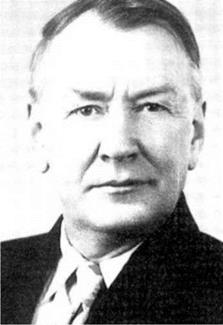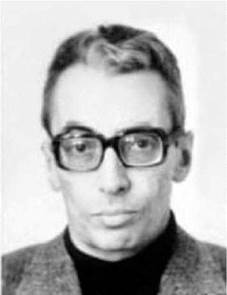INTRODUCING THE FATHER OF THE SOVIET MOON PROGRAMME: MIKHAIL TIKHONRAVOV
Tikhonravov’s background in the space programme went as far back as Korolev’s, even though he was much less publicly prominent. But what do we know about Mikhail Tikhonravov? Mikhail Tikhonravov was the architect of the Soviet moon
|
GIRD-09 |
programme. He was born 16th July 1900 (os)[1] and began his early aeronautical career by studying the flight characteristics of birds and insects. In 1922, his study called Some statistical and aerodynamical data on birds was published in Aircraft magazine. He graduated from the Zhukovsky air force academy in 1925 and worked in aviation. In 1932 he joined Korolev’s group of amateur rocketeers, the GIRD (Group for the study of jet propulsion), moving in and out of rocketry and jet propulsion in the 1930s and 1940s. He wrote Density of air and its change with altitude for a military magazine in 1924. Seven more articles on aeronautics appeared by 1939. In the course of his work he met the ageing theoretician Konstantin Tsiolkovsky and joined the Moscow GIRD. He was closely involved with Korolev in the construction of amateur rockets launched over 1933-5. The Moscow group had fired the first liquid-fuel Russian rocket from a forest near Moscow. The rocket was called the GIRD-09, a needlelike contraption just able to fly higher than the tall trees. Launching on 17th August 1933, it reached the mighty height of400minits 18 sec mission. The GIRD rocket was designed by Mikhail Tikhonravov. The work of these young rocketeers and theoreticians was later to become extremely significant for the later moon missions. GIRD was supervised by a technical council with four teams, led respectively by Friedrich Tsander, Sergei Korolev, Yuri Pobedonostsev and Mikhail Tikhonravov, with Tikhonravov having responsibility for liquid propellants [7]. The group was really driven by Sergei Korolev (born 30th December 1906 (os)), a graduate of Moscow Higher Technical School who designed, built and flew his own gliders and for which he developed rockets as a means to get them airborne.
Tikhonravov wrote a book on space travel in 1935 and then disappears from the records until the end period of the war. He was one of the few to escape the purges. Tikhonravov was a talented man who painted oils in his spare time and studied insects and beetles. Tikhonravov re-emerged in 1944 designing high-altitude rockets for the Lebedev Institute of the Academy of Sciences and two years later was transferred to Scientific Research Institute NII-4, staffed mainly by artillery officers, to design and build missiles. In the later 1940s, his name reappears on an edited book on the writings of Konstantin Tsiolkovsky and Friedrich Tsander. Tikhonravov designed the first plans for sending humans into space – the VR-190 suborbital rocket, able to send two stratonauts on an up-and-down mission 200 km high, a flight eventually emulated by Alan Shepard and Virgil Grissom in 1961. From 1948 onward, Tikhonravov worked for the Artillery Academy of Sciences and put forward the idea of grouping rockets together in a cluster of packets to achieve new velocities and lifting power. It was at such a presentation attended by Korolev in 1948 that the two men resumed their collaboration that had been broken by the purges [8]. On 15th March 1950, Tikhonravov put forward one of the formative papers of the Soviet space programme, with a convoluted but self-explanatory title: On the possibility of achieving first cosmic velocity and creating an Earth satellite with the aid of a multi-stage missile using the current level of technology.
This paper caused a stir and indeed led to Tikhonravov’s banishment. In the final, paranoid days of Stalin, he fell under suspicion for giving unwarranted attention to non-military affairs and for not concentrating sufficiently on the defence of the motherland. He was demoted, rather than imprisoned or worse, but ironically this gave him all the more time to consider long-term objectives. During this period of reflection, the article for Pionerskaya Pravda was conceived. Following the death of Stalin, he was restored to his old work in the Directorate of the Deputy Commander of Artillery. There, he organized the ‘satellite team’ that paved the way for the Soviet Union to launch the first Sputnik. His memorandum A report on an artificial satellite of the Earth (25th May 1954) included a final section called Problems of reaching the moon which outlined a 1,500 kg spacecraft to land on the moon and return using atmospheric braking. His ideas had now moved from a children’s newspaper to an official Soviet document in the period of three years.
April 1956 saw the Soviet Academy of Sciences organize the all-Union conference
On rocket research into the upper layers of the atmosphere. Here, Sergei Korolev made a lengthy presentation. He told the conference:
It is also a real task to prepare the flight of a rocket to the moon and back to the Earth. The simplest way to solve this problem is to launch a probe from an Earth satellite orbit. At the same time, it is possible to perform such a flight directly from the Earth. These are prospects of the not too distant future.
Department # 9 was later reorganized and subtitled the ‘Planning department for the development of space apparatus’. In April 1957, the planning department produced a detailed technical document, A project research plan for the creation ofpiloted satellites and automatic spacecraft for lunar exploration. The key question, iterated by Tikhon – ravov, was the need to construct an upper stage for the planned intercontinental ballistic missile. Meantime, the Academy of Sciences appointed the Commission on Interplanetary Communications to oversee the planning or ‘the conquest of cosmic space’: vice-chairman was Mikhail Tikhonravov.
There the matter rested for the moment, as OKB-1 focused on the great challenge of launching an artificial Earth satellite that autumn.
Chronology of the idea of a Soviet moon rocket
1951 Flight to the moon by Mikhail Tikhonravov in Pionerskaya Pravda.
1954 Report on an artificial satellite of the Earth by Tikhonravov, Glushko and Keldysh.
1955 On the question of the application of rockets for research into the upper layers of the atmosphere by Sergei Korolev.
1956 Conference on moon in Leningrad State University (February).
Korolev formally announces goal of moon mission (April) at conference On rocket research into the upper layers of the atmosphere.
Artillery institute’s research institute NII-4 transferred to OKB-1 as Department #9 under Tikhonravov.
1957 Department #9’s Project research plan for the creation of piloted satellites and automatic spacecraft for lunar exploration (April).
Academy of Sciences establishes the Commission on Interplanetary Communications, led by Tikhonravov.






















